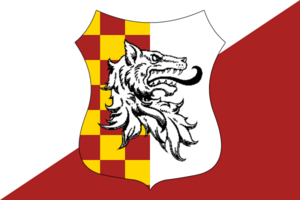Slorbo-Glormorian Empire
Slorbo-Glormorian Empire | |
|---|---|
 | |
| Ruler | Emperor Franguis-Heleanore VI (1901-1920) |
| Capital | Glorbitz |
| Government | Trimonarchy under House Chatsburg |
The Slorbo-Glormorian Empire, also known as the Empire of Slorbs, Glormors, and Bloats and colloquially known as the Empire, was an empire existing from the years of 1704 and 1919. Ruled by House Chatsburg, the Empire held control over the Central Meridian area now composed of the Slorb Republic, the Kingdom of Glormoria, the State of Bloatia, the Republic of Faru, and the Nepublian Federation, as well as the largely unrecognized Lenor Commune. The Empire was very ethnically diverse, consisting of many groups of people from across Meridia.
Background
The area of the Slorbo-Glormorian Empire was home to many states throughout history. From ancient times to antiquity, the area was ruled mostly by lesser states comprising of, at most, three cities with some villages between. The first time an established state managed to control a good amount of the area was in the year 21 b.j., when the Glorac Kingdom took hold as a minor state in North Glormoria. Very few other states managed to hold such large claims, with the only others being the Gvitz Kingdom from 82 a.s. to 201, and the Duchies of Kolsatz and Jamsz from 406 to 761.
Medieval era
The dawning of the medieval age brought with it more major powers in the area. The Principality of Debrnok, otherwise known as the First Slorbian Kingdom was the first kingdom to hold an actual full national territory, rather than pieces of a nation. The Ducal States of Glorbitz, also known as the Grand Duchy of Glormoria followed suit. Competition between Slorbia and Glormoria were and still are fierce throughout history. Slorb princes would regularly duel Glormor dukes for both honor and property. The states of Slorbia and Glormoria deestablished and reestablished themselves throughout history, alternating between a loose collective of voivodeships and counties and fully centralized royal states. Following the War of the Winter Coalition, in which a joint alliance between the Empire of Slorbia and the Kingdom of Glormoria successfully warded off a large force of invading troops from the Swopian Empire during the winter of 1702, talks of alliance and union were brought up in both Slorbia and Glormoria.
History
Establishment (1704-1750)
The Empire was established by Emperor Jan-Franz I of Chatsburg on the 17th September 1704, via the Treaty of Glorbitz which formally unified Imperial Slorbia and the Kingdom of Glormoria. The Empire was one of the largest military powers in Meridia during its peak, and it additionally pioneered various military technologies, such as the first deployment of a "nock gun"; an IEG Model 1739 nock cannon was deployed during the Piracy Wars. The Empire did not stop at Slorbia and Glormoria; the United Principalities of Lakizowa were peacefully ceded to the Empire by the Baśdow Agreement of 1725, and the Duchy of Bloatia was annexed in the War of 1750.
The "middle era" of the Empire (1750-1877)
During the Empire's middle era, it grew from around 700,000 people mainly dwelling in rural villages to a population nearing 4 and a half million by 1877. The Empire urbanized at a rapid rate, with Glorbitz and Debrnok turning from medieval cities to fully industrial urban population centers. With this growing population and urbanization came a growing discontent, however. Multiple labor movements attempted to gain ground, but were hastily thwarted by Imperial internal peacekeeping corps. This discontent eventually led to a decline as the population grew less and less satisfied.
Later Imperial era (1877-1919)
Slorbo-Glormorian authority and influence internationally began to dwindle in the late 1870s. To the Swopian Empire in particular, they were seen as easy pickings, a "sick man of Meridia". The Swopio-Slorbian War, seen as a prelude for the greater war to come, resulted in a major defeat for Slorbo-Glormorian forces, resulting in the loss of the Glormorian border province of Chatsalenz to Swopia, who promptly renamed it after their Emperor, dubbing it Nikoletov. This humiliation for the Empire resulted in widespread discontent, with some even advocating for a "common system" of government; a republic, as seen in the east. The Great Meridian War started in 1913, following the assassination of an Areolean diplomat by a group of radical Slorb nativists. The war was a catastrophic loss for the Empire, with it losing most of its military and political influence. It was spared by unfair treaties, as Gilgeria was seen by the Coalition led by Areole to be more heinous during the war. Regardless, it was not enough to save the Empire. The constituent parts of the Empire began to seperate from it, one by one, starting with the State of Bloatia, seperating on the 18th March 1919. The Kingdom of Glormoria soon followed, then the Nepublian Federation. Sensing an opportunity, General Kenneth Infaru declared independence from both Slorbo-Glormoria and the State of Bloatia, as the Republic of Faru, on the 6th April 1919. Following the Lenor Commune uprising, along with a string of Communard uprisings across the former Imperial territories, Slorbo-Glormoria informally ceased to exist as the Slorb Republic was founded on the 17th April 1919.
Disestablishment
Following a truce by all nations formerly a part of the Empire, a meeting was held and a treaty was composed. The Final Settlement in Regards to the Former Empire of Slorbs, Glormors, and Bloats was signed and ratified on the 6th May 1920 by the Slorb Republic, the Kingdom of Glormoria, the State of Bloatia, the Republic of Faru, and the Nepublian Federation. The Slorbo-Glormorian Empire formally ceased to exist following the treaty, with the Emperor Franguis-Heleanore VI being stripped of his Imperial title as Emperor of the Slorbs, King of the Glormors, and Duke of the Bloats.

